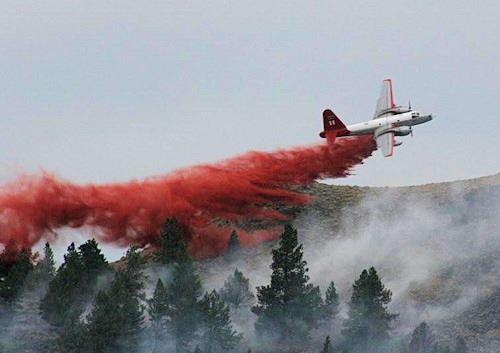By Sophie Quinton, Stateline
Josh Baker just got home from a 50-day deployment to three California wildfires. Although his job wasn’t dangerous — he worked on a support team, making calls to track down equipment such as port-a-potties and bulldozers — the hours were long, the stakes were high and the work was exhausting.

He’s still feeling tense. “I’m anxious, nerves are kind of frayed, things that would normally not be a big deal — kind of water off a duck’s back — hit a little harder,” said Baker, a California Department of Forestry and Fire Protection (Cal Fire) fire captain who spoke to Stateline as a member of the agency’s union, Local 2881.
Being a wildland firefighter has always involved long hours, personal risk and weeks away from home. But this year has been something else: More than 4 million acres burned in California alone. Entire towns were torched in Washington and Oregon. Smoke was so thick the sky turned orange over West Coast cities.
Now state and federal officials and mental health experts are bracing for firefighters to come home and start processing what they’ve been through. It’s not uncommon for wildland firefighters, even in a less-intense year, to develop depression, post-traumatic stress disorder, unhealthy substance use or suicidal thoughts.
“When you almost die on a wildfire, away from your family and kids — that doesn’t go away,” said a U.S. Forest Service smokejumper who asked to remain anonymous for fear of reprisal from his employer. “I know people who wake up in the middle of the night, and in their dreams they’re getting burned over by a fire, because they almost did.”
This year feels like a breaking point for many firefighters, said Mike West, who resigned as a fire dispatcher for the U.S. Forest Service this summer after 17 years working various fire-related jobs for the agency. His resignation letter, which detailed his struggles with post-traumatic stress, has been widely shared online.
“People are burned out,” West said. “They’re incredibly tired. And I think it’s been building for several years, and this is the year people are finally being more open [about mental health].”
State and federal agencies are trying to connect employees with counselors, chaplains and tools for managing trauma. But union officials and mental health experts say state and federal lawmakers must also fund more firefighter jobs and improve pay and mental health benefits, with severe fire seasons set to increase because of climate change.
“We can’t even get relief for our guys on these major fires,” said Tim Edwards, president of Local 2881. He wants the California legislature to hire hundreds more full-time firefighters to give people like Baker more time off to decompress. But state budgets are tight because of the pandemic and face many competing priorities.
The Forest Service smokejumper has started an online petition asking Congress to pay for a psychologist at every National Forest headquarters, mental health paid leave, better salaries for entry-level firefighters and better benefits for temporary employees. Federal firefighter salaries start at about $26,000 a year, not including hazard pay.
“The whole thing, to me, is mental health,” he said of his proposals. “To me [hiring] the psychologist is treating the problem. It’s not preventing it.”
The petition has collected more than 30,000 signatures in two months.
Some firefighters are heading home with memories of crew members who died in a fire. Others have lost their homes to wildfire or are returning to damaged communities. And like everyone else, they’re contending with the coronavirus pandemic.
Baker had been home with his wife and young daughter for less than an hour when he learned that a firefighter he’d worked with had COVID-19. Baker cloistered himself in a spare room for a few days until his own test results came back negative.
Some forestry experts say the pressure on firefighters will subside only when policymakers and the public invest more money in reducing wildfire risk, such as by clearing brush from around homes. Western states such as California have been ramping up investment in such projects.
“Ultimately, that’s what’s going to make it safer for fighters, is a healthy, restored, resilient ecosystem,” said Tim Ingalsbee, a wildland fire ecologist and executive director of Firefighters United for Safety, Ethics and Ecology, a Eugene, Oregon-based nonprofit.
An Increasingly Stressful Job
Tens of thousands of Americans are involved in fighting wildfires, from full-time federal and state employees to seasonal hires, private contractors, prison inmate crews and local fire department volunteers. Cal Fire alone employs 6,100 full-time fire professionals and 2,600 seasonal firefighters.
Unlike their city counterparts, wildland firefighters typically deploy for weeks or months, working long hours and usually sleeping in tents or catching quick naps in the dirt. When employees go home at the end of a fire season, it can be tough to readjust to normal life.
“That’s when the post-traumatic stress takes its toll on the wildland guys, the off-season,” said Burk Minor, director of the Wildland Firefighter Foundation, a Boise, Idaho-based group that raises money to help injured firefighters and the families of firefighters who died on the job.
West said that for years, he suppressed feelings about two close calls escaping wildfires in his early 20s. Going home became a struggle, particularly after his kids were born. “I was really hyper-vigilant, you know,” he said. He startled easily and would grow impatient and irritable when, for instance, a line at a restaurant buffet moved slowly.
The job has become more dangerous in recent years, largely because of climate change. Dry conditions and high winds in California are fueling fire behavior that firefighters have never seen before, Baker said.
“I hate to say it, because it sounds cliché, but every time we have these large-scale fires we say, ‘This is a career fire,’ or, ‘You’ll never see this again in your career,’” he said. “And every year, you’re topping that.”
In a farewell letter posted online this spring, Aaron Humphrey, a California hotshot crew supervisor (hotshots are on the front lines of fighting fire) explained that the 2018 Carr Fire — a blaze so intense it spawned a terrifying tornado — was his breaking point, reached after years of suppressing the strain of managing a fire crew.
“The day the fire tornado came and everyone did the best they could I lost the mental fight. … I felt dead inside that night,” he wrote. He spiraled into angry outbursts, heavy drinking and depression.
And as fires grow and more people move to forested areas, firefighters are both facing more pressure to protect communities and witnessing more human suffering.
“Now if you even lose one acre, that could be several people’s homes,” said Nelda St. Clair, a retired U.S. Bureau of Land Management (BLM) administrator who now manages crisis stress management training for wildland firefighters for the U.S. Bureau of Indian Affairs.
“The suicide rate in wildland fire is much higher than it is in municipal fire departments, or the general population,” said St. Clair, who keeps an informal tally of wildland firefighter suicides.
She said many wildland firefighters who die by suicide have experienced a traumatic event on the job, which can later fuel stress disorders, relationship problems and unhealthy substance use.
West said that after a close friend of his died on the fire line in 2013, the negative thoughts and emotions he’d been battling for years intensified. By 2017, he said, “I was having nightmares, I was having anxiety memory loss.” He had suicidal thoughts, too.
A Changing Culture
State and federal agencies have for decades conducted mental health training for wildland firefighters after catastrophic events, such as the death of a fire crew member. More recently, agency leaders have ramped up efforts to prepare firefighters for stressful and traumatic experiences and to encourage them to reach out for help.
“What we’ve been very successful at is changing the culture,” said Ted Mason, fire and aviation national safety program manager for the BLM. He said the profession is shifting away from the traditional, suck-it-up stoicism of first responders.
Cal Fire now has about 20 staff members who work full time with struggling employees and recommend counseling services and other resources, said Mike Ming, staff chief of Cal Fire’s behavioral health and wellness program. The agency also has trained staff all over the state to serve as peer support personnel who can offer colleagues a friendly ear.
Ming’s team sometimes sets up trailers at fire base camps that firefighters can duck into for a confidential discussion with a trained peer. Sometimes, he said, firefighters will walk into a trailer and just start crying.
The agency also is training firefighters to recognize the signs of stress and trauma and combat them with techniques such as deep breathing, Ming said. “Over time, if they don’t have the positive coping tools and skills … oftentimes people find themselves on their knees reaching out for help.”
But more needs to be done, St. Clair said. Although the culture of wildland firefighting is changing, “we’re not there yet.”
It’s difficult for anyone to reach out and ask for help, she said. “It’s more difficult for a wildland firefighter. They’re terrified that if anybody knows about it they’ll lose their jobs. They’re terrified that the people they depend on won’t trust them.”
And some employees still slip through the cracks. State and federal jobs generally offer an employee assistance program that includes access to a handful of free counseling sessions, for instance. But temporary workers lose access to that benefit when they’re laid off at the end of fire season.
People experiencing post-traumatic stress can need more specific help than general counseling. After initially being referred to a local marriage counselor by the Forest Service’s employee assistance program, West, who lives in a rural area that has few mental health providers, decided instead to drive 90 miles to see a trauma specialist.
“The guy was very nice,” West said of the marriage counselor. “But he didn’t really understand firefighting or what I was dealing with.”
It can also be difficult for firefighters to claim workers compensation for post-traumatic stress disorder, particularly at the federal level.
California lawmakers last year approved legislation that will make it easier for certain state and local firefighters and law enforcement officers to make such claims from 2020 to 2025. As of last March, Florida and Minnesota had similar laws on the books, according to the National Conference of State Legislatures, a Denver and Washington, D.C.-based group that advises state lawmakers.
Next Steps
This fire season has been so bad that agency officials and union leaders are calling for more mental health support for wildland firefighters and other public lands employees.
The Oregon State Department of Forestry has hired an outside contractor to connect employees with mental health professionals and chaplains. “These fires hit home for a lot of our employees,” said Patricia Kershaw, human resources manager for the agency. “It’s communities where they live, some lost their homes, some had families that lost their homes.”
U.S. Forest Service management and union leaders are discussing how to better support workers in Western states, said Randy Meyer, safety committee chair for the Forest Service Council of the National Federation of Federal Employees.
“There’s been a lot of talk about trying to delve into critical stress management,” Meyer said, “and possible or even probable PTSD issues with firefighters in particular, but our Forest Service employees in general.” Some employees have watched decades of work on public lands go up in smoke, he said.
Meyer said there’s also talk of expanding the agency’s employee assistance program to temporary workers after they’ve been laid off. But that might require an act of Congress.
“It’s not just a fiscal issue,” Meyer said. “We can’t spend money on people that aren’t employed by the agency.”
Baker agreed with Edwards, the Local 2881 president, that while it’s vital for firefighters to have mental health support they also need more time to go home and unwind between deployments.
“While having those resources is great,” he said, “it’s putting a Band-Aid on a bigger issue, which is the amount of personnel.”
The recession caused by the pandemic has squeezed state budgets and made new investments difficult, however. California Gov. Gavin Newsom, a Democrat, in January proposed spending $120 million this year and $150 million in future years to hire 677 more full-time Cal Fire firefighters and staff.
The legislature instead approved — and the governor in June enacted — $85.6 million to hire 172 new full-time firefighters and staff, as well as seasonal workers. Newsom later used emergency funds to hire over 850 more seasonal firefighters.
The Forest Service smokejumper said anecdotally he’s hearing wildland firefighter jobs are getting harder to fill, perhaps because of the low pay, tough schedule and risk. “There are less and less people who want to do that,” he said.
West is now working as an eighth-grade teacher, fulfilling a longtime dream and spending more time with his wife and two young kids. He said he no longer feels ashamed or embarrassed by his mental health struggles. “Hearing other people talk about it helped me talk about it,” he said.
Stateline, an initiative of The Pew Charitable Trusts.

